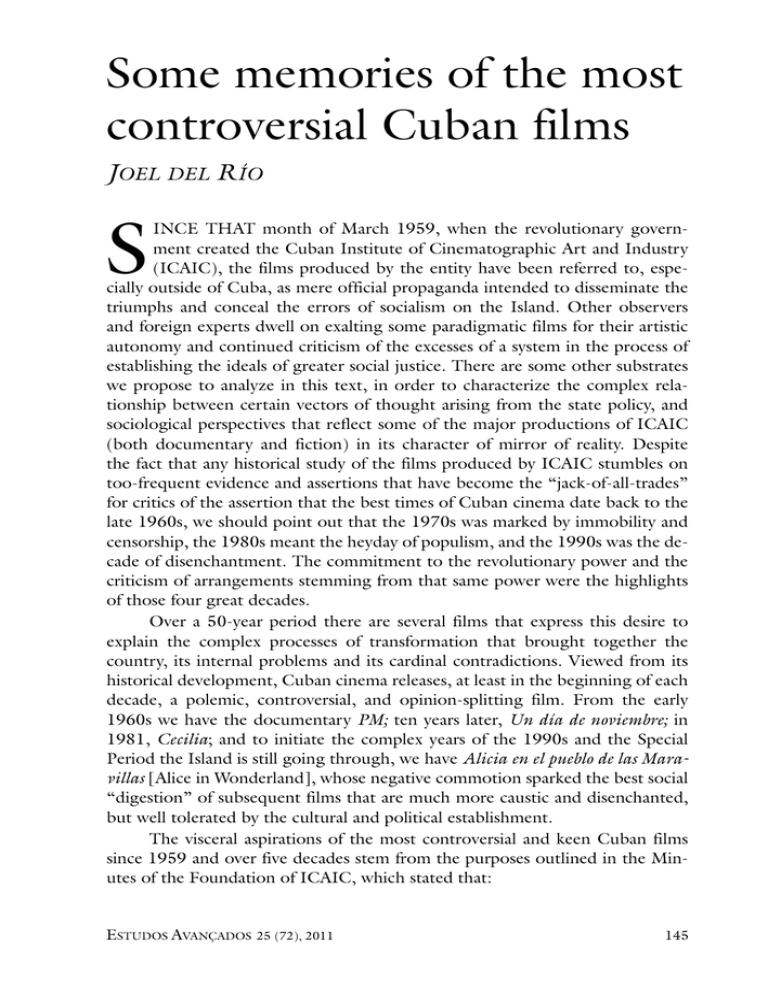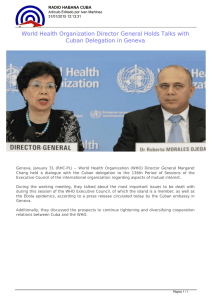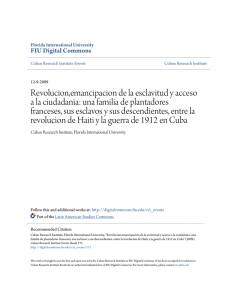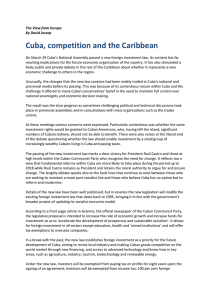English
Anuncio

Some memories of the most controversial Cuban films Joel del Río S ince that month of March 1959, when the revolutionary government created the Cuban Institute of Cinematographic Art and Industry (ICAIC), the films produced by the entity have been referred to, especially outside of Cuba, as mere official propaganda intended to disseminate the triumphs and conceal the errors of socialism on the Island. Other observers and foreign experts dwell on exalting some paradigmatic films for their artistic autonomy and continued criticism of the excesses of a system in the process of establishing the ideals of greater social justice. There are some other substrates we propose to analyze in this text, in order to characterize the complex relationship between certain vectors of thought arising from the state policy, and sociological perspectives that reflect some of the major productions of ICAIC (both documentary and fiction) in its character of mirror of reality. Despite the fact that any historical study of the films produced by ICAIC stumbles on too-frequent evidence and assertions that have become the “jack-of-all-trades” for critics of the assertion that the best times of Cuban cinema date back to the late 1960s, we should point out that the 1970s was marked by immobility and censorship, the 1980s meant the heyday of populism, and the 1990s was the decade of disenchantment. The commitment to the revolutionary power and the criticism of arrangements stemming from that same power were the highlights of those four great decades. Over a 50-year period there are several films that express this desire to explain the complex processes of transformation that brought together the country, its internal problems and its cardinal contradictions. Viewed from its historical development, Cuban cinema releases, at least in the beginning of each decade, a polemic, controversial, and opinion-splitting film. From the early 1960s we have the documentary PM; ten years later, Un día de noviembre; in 1981, Cecilia; and to initiate the complex years of the 1990s and the Special Period the Island is still going through, we have Alicia en el pueblo de las Maravillas [Alice in Wonderland], whose negative commotion sparked the best social “digestion” of subsequent films that are much more caustic and disenchanted, but well tolerated by the cultural and political establishment. The visceral aspirations of the most controversial and keen Cuban films since 1959 and over five decades stem from the purposes outlined in the Minutes of the Foundation of ICAIC, which stated that: estudos avançados 25 (72), 2011 145 Santiago Alvarez 146 estudos avançados 25 (72), 2011 Cinema represents, by virtue of its characteristics, an instrument of opinion and formation of individual and collective consciousness [...] should represent an appeal to the conscience and should help abolish ignorance, elucidate problems, propose solutions and present, in a dramatic and contemporary way, the great conflicts of man and humanity. A few months after the enactment of the law creating ICAIC, Cuba witnessed the first major dissension among the cultural policy of the Revolution and some artists and intellectuals, brought about by a documentary portraying a certain tangential observation of underdevelopment and marginalization. The prohibition of the documentary PM (1961), directed by Orlando Jiménez Leal and Sabá Cabrera Infante,1 followed by a few weeks the invasion of Playa Girón, after socialism had been proclaimed in Cuba and in a climate still tense due to the then recent victory over the U.S. counterrevolutionary attack on Playa Girón. The climate was far from favorable for showing this documentary produced in the direct cinema style, which portrays an early evening in a bar near the port of Havana. There, a group of men and women surrender to the rumba, tobacco and alcohol, in a rather carefree and fun atmosphere, apparently totally unrelated to the mobilization experienced by the country as a result of the counterrevolutionary military attack. ICAIC’s refusal to show PM led to three meetings held at the National Library, with the participation of Fidel Castro and the majority of the Cuban artistic and intellectual community. These meetings resulted in the well-known Words to the Intellectuals, which established a field of action for the arts with the statement, then converted into a motto: “Within the Revolution everything, against the Revolution nothing”,2 which would be subjected to the most diverse and even opposing interpretations, since the decision to indicate what is within or against the Revolution depended on very personal points of view. Fidel assured in that same speech that: The Revolution should never give up relying on the majority of the people; it must rely not only on the revolutionaries, but on all honest citizens who, although they may not have a revolutionary attitude toward life, are with the Revolution. The Revolution should only turn its back on those who are incorrigible reactionaries, who are incorrigible counterrevolutionaries. Among the first ICAIC documentaries that followed, in a way, the aesthetic and conceptual designs of PM was Ciclón (Cyclone, Santiago Álvarez, 1963), which also dispensed with dialogues to provide an eloquent and honest account of the devastation caused by Hurricane Flora in the provinces of Oriente and Camaguey. From the unusual expressive power of images and settings, Ciclón alludes tangentially to the backwardness and lack of mental, spiritual and material development of the Cuban people at the time of the revolutionary triumph. estudos avançados 25 (72), 2011 147 Photo by Adalberto Roque/aFP Humberto Solas Juan Carlos Tabío Similar factors responsible for delaying development are the focus of two of the best Cuban documentaries of all time: Vaqueros del Cauto [Cowboys of Cauto] (1963), by Oscar Valdés, and Por primera vez (1967), by Octavio Cortázar. There is also a triad of documentaries directed by Nicolás Guillén Landrián witnessing the enormous burden of underdevelopment and marginalization facing the Revolution: En um barrio viejo (1963), Ociel del Toa and Reportaje, both from 1966, but the new delusional focus of censors would be Coffea arabiga (1968), by the same director. Conceived as an educational documentary about the fervent coffee harvest intended to maximize the production of the “aromatic grain”, the film used the methods of the propaganda harangue to subvert them with mild irony and raise doubts about the rash and aprioristic optimism of slogans and mottos, of the obsession with targets and of the cyclical rush towards productivity and even death. Coffea arabiga did not enjoy the enthusiastic support of the leadership of ICAIC and its director gradually became a “persona non grata” in intellectual and official circles. Some people felt particularly uncomfortable with the use of the Beatles’ song Fool on the Hill linked to images of Fidel Castro. The fact that Guillén Landrián’s documentary intended to poetically exalt rather than question the ability to dream and create of the enlightened leader, failed to be understood. The creed of criticism as an inseparable part of art was sustained by Alfredo Guevara, president of ICAIC, in the article “El cine cubano de 1963”, published in issue 14-15 of Cine Cubano magazine: 148 estudos avançados 25 (72), 2011 Photo by Rafael Perez / Reuters Beside Coppola, Fernando Pérez receives the Coral Award for his film La vida es silbar. Every search imposes breaking bondages and requires a point in development to be nothing more than that: a starting point. It is to that extent that we can say that intellectual work is always an adventure, and that the intellectual ends up almost automatically condemned to heresy. The first Cuban fiction film markedly heretical, that is, dedicated to establishing piercing issues about the nonsense and mechanisms established by the Caribbean socialism was La muerte de un burócrata (1966), the first great work by Tomás Gutiérrez Alea and certainly the best comedy ever in the history of national cinema, especially thanks to the transtextual assimilation of traditional genres such as situation, satirical and dark humor comedy (in a nonsensical variant), with a nationalist cinema that was not only contemporary but also eager to communicate with the natural viewer and determined to find modern, adequate and effective narratives and styles. A relentless vitriol dripped from La muerte..., not only because it portrays the curse represented by schematic and inflexible employees who lead the protagonist to despair and create chaos around a simple and essential proceeding, but also because it lashes out, with devastating sarcasm, against the stereotyped and formal rituals of bureaucrats and their rhetoric fraught with commonplaces. Very much inspired by the characters of the British free cinema, by the subjective neo-realism of Antonioni and especially by the anti-heroes of the new estudos avançados 25 (72), 2011 149 French wave represented by Godard and Resnais, Sergio, the protagonist of Memorias del subdesarrollo (1968, t. Gutiérrez Alea), searches in his memory for the “lost”, past, irretrievable time, and oscillates, in his helpless lucidity, in the solitude and heaviness that can be neither shared nor mitigated, between a past which he could only look at with wrath and a present that failed to offer him the values and the safety he needed. The internal exile of the character, the ostracism of the different, the alternative and deeply critical viewpoint about the cultural context and the official discourse converted Memorias... into a rediscovery of the pleasures embodied in the risk and exercise of creative freedom. The film was understood as an instrument for showing experience, seeking innovation, discovering new paths and venturing to tread them. Two years after the premiere of Memorias del subdesarrollo in 1970, adding to a major setback in the economic history of the Revolution (the failure of the 10 million sugar harvest, which would have meant an important guarantee of greater political independence and improvements in living standards), ICAIC was unable to produce at least one fiction feature film. The whole country was paralyzed, engaged in the productive effort of the so-called Ten Million Harvest. In 1971 the First National Congress of Education and Culture was held, in which several very tough questions were raised by members of the Communist Party about the open and inclusive policy of ICAIC, especially regarding the release of films representing the “decadent capitalism”. The Congress was the culmination of an Offensive Revolutionary campaign established since the late 1960s, which sought to radicalize the adjustment of the principles of socialism in the areas of culture and, of course, economy and politics. The Congress asked ICAIC not only to continue but also to increase the production of historical films and documentaries as a means of linking the present to the past and showing different forms of cinematographic dissemination and education. These circumstances, among others, resulted in a Cuban cinema that for some time strayed from its visceral critical and questioning vocation. In that heated and sectarian atmosphere, Humberto Solás produced his second fiction feature film, in which the “other” resurfaces as a character that isolates himself from the revolutionary process because he does not understand it or because he is incapable of actively participating in it. Five years after the issues raised by Sergio in Memorias del subdesarrollo, we have the Esteban of Un día de noviembre (1972), a man unable to share the optimism of the harvest, the labor goals and the rumba, for as solid a reason as finding out that he has a terminal disease. Un día de noviembre was only released six years after its completion, because the Cuban cinema of the 1970s had virtually no interest in contemporaneity. That was the period in which the historic film was more alive than ever before or after, in an attempt to postpone the findings of epic films as unique as Lucía (1968, Humbert SOLAS) and La primera carga al machete (1969, Manuel Octavio Gómez). Based mainly on the Brazilian film Deus e o diabo na terra do Sol [God and the Devil in the Land of the Sun], the film Una 150 estudos avançados 25 (72), 2011 pelea cubana contra los demonios [A Cuban Struggle against Demons] (1971), by Tomás Gutiérrez Alea, illustrates the atmosphere of bigotry and hysterical intolerance that prevailed in seventeenth century Cuba. Narration and discourse are dominated by the desire to present a frank and subtle argument against the dogmatism and extremism represented by the Church and the Spanish metropolis, both allied to a government that enforces stifling laws against individual initiative (trade), and condemns as heretic all that means exchange with the world, open views and transformative creativity for the benefit of the individual. Gutiérrez Alea was the filmmaker who best succeeded in alluding to the present from the generalizing metaphors of the historical cinema. The staging of the Last Supper of Christ with the apostles, by a count who owned a sugar mill in eighteenth century Cuba, is the main focus of La última cena (1976), an outstanding example of the production of the time full of allusions to the present, or rather of timeless reflective postulates about the demagoguery and manipulations of the government, about resignation in the face of adversity and of satire and “choteo” (form of mockery) as a way to escape the repressive and authoritarian solemnity. In parallel with the increased production of historical films at that time, the effort to criticize life in Cuba before 1959 continued, as clearly seen in Los días del agua (The Days of Water, Octavio Gómez, 1971) and further ratified in the documentary ¡Viva la Republica! (1972, Pastor Veja) and in the dark humor comedy Los sobrevivientes (1978, Tomás Gutiérrez Alea). However, it should be pointed out that although the 1960s was a period of strong dissemination of the principles of socialism - sometimes directly promoting the successes of the new social system, and others denigrating the capitalist decadence of the past this kind of acquiescence of the cinema to official policies did not preclude the production of other types of films from different frames of reference, unrelated to direct propaganda. In a similar environment, and among people very similar to those of PM , we have the 29 minutes of Escenas de los muelles [Scenes of the Piers] (1970, Oscar Valdés), one of ICAIC’s first productions recognizing the existence of marginal habits distant from the labor and proletarian ethics contemplated by the Revolution. Through the merger of drama and testimony, the director shows the friendship between two port workers, in clear opposition to the precepts dictated by the philosophy of the new man. Some films continued to portray, at first timidly and then openly, the internal economic inefficiency, poverty and even the obscurantism and backwardness that prevailed in many spheres of life. The lack of control or nepotism, close to administrative chaos, in Ustedes tienen la palabra (1973, Manuel Octavio Gómez); the macho and marginal remnants, a hindrance typical of underdevelopment that precludes the progress of the new socialist morality in De cierta manera (1974, Sara Gómez); and the inability of man, of the family and even of some social sectors to accept the full and complete equality of women in Retrato de Teresa (1979, Pastor Veja) warn about a Cuba far from the ideal of equality to which it aspired. estudos avançados 25 (72), 2011 151 Eduardo Muñoz Bachs. Letters from the Park, 1989. Cuban film. Director: Tomaz Gutiérrez Alea. Eduardo Muñoz Bachs. Secondary Roles, 1989. Cuba/ Spain production. Director: Orlando Rojas. The lapse that connects the 1970s to the 1980s relates to a very modest weakening in the constant tensions between the Cuban and U.S. governments. Shortly after the brief tension disappeared, as a result of the success at the Peruvian Embassy (invaded by hundreds of Cubans seeking to immigrate), and the massive exodus from the port of Mariel. After that, the Soviet Union started the process of economic reform (Perestroika) and information transparency (glasnost), which had strong repercussions in Cuba and would be concluded in the 1990s with the demise of so-called real socialism in Eastern Europe. The Cuban version of these political and social phenomena became known as ‘process of rectification of errors and negative trends’, and its main consequence was associated with the incentive to criticism and self-criticism throughout the media. Before the ICAIC could echo all these changes, the fiction feature film Cecilia was released, marking the crisis of the institution as a propelling force of an auteur’s cinema of historical or literary bent. The quality of a film and the development policy of a cultural institution had never been so strongly challenged in Cuba. The scandal of Cecilia led to a change in the leadership and production 152 estudos avançados 25 (72), 2011 Raúl Martínez. Lucia, 1968. Cuban film. Director: Humberto Solas. Eduardo Muñoz Bachs. Better Late Than Never, 1987. Cuban documentary. Director: Enrique Colina. policy of ICAIC, since most of the production of the Cuban cinema of the 1980s would stray from the authorial and historicist tendency towards popular culture, the contemporary and generic, especially within the codes of sitcoms. Since 1975, in the text Una imagen recorre el mundo, Julio García-Espinosa had been referring critically to the aristocratic attitude of those who disdained the commercial cinema, advocating the need for a dramaturgy of daily life that offered answers to the demands of the audience and the industrial principles of the cinema. The first two films representing this desire to approach the massive audience, after the crisis marked by Cecilia, were Se permuta (1983, Juan Carlos Tabío) and Los pájaros tirándole a la escopeta [Birds shooting the shotgun] (1984, Rolando Diaz), two situation comedies that introduced some of the major themes prevailing in that decade: the new generation, the renewal of youth and its search for a suitable place in society. This arrival of young filmmakers with their freshness and natural demands, coupled with their indisputable penchant for renewal and questioning was expressed in a long list of films, either comedies or dramas, such as Se permuta and Los pájaros… Demasiado miedo a estudos avançados 25 (72), 2011 153 la vida or Plaff (1988, Juan Carlos Tabío), Papeles secundarios (1989, Orlando Rojas), Alicia en el pueblo de las Maravillas (1990, Daniel Díaz Torres) and Adorables mentiras (1991, Gerardo Chijona), among many others. All these films depict different levels of conflict arising from the dynamic action of the young generation against ancestral damages and outdated dogmas. An authentic portrayal of these generational contradictions is seen in Juan Carlos Tabío’s films, particularly Plaff, which shows the vertical contrast of attitudes between a woman and her daughter-in-law, the former completely closed in her bigotry, double standards, schemes and fears of every transformation, while the young daughter-in-law represents a free and active generation, eager for achievements and innovations. The renewing dissatisfaction of the young woman is constantly sabotaged by the bureaucrats on call or the mindset of the mother-in-law, a human being impervious to dialectics. Along with the contemporary youth theme we have the constant criticism of the main obstacle that precluded the full integration of women in society: sexism, the hindrance to underdevelopment. Hasta cierto punto [Up to a certain point] (1983, Tomás Gutiérrez Alea) denounces the self-indulgence and losses of some intellectuals and artists with their stereotypical representations of the working universe and their contradictions in relation work, ideology and race. The documentary El Fanguito (1990, Jorge Luis Sánchez) also indirectly touches on the vision of black people shackled by the stigma of marginality, members of a disadvantaged social class, reduced (by multiple historical and mental reasons) to the lower strata of society, as implied in the documentary PM, as well as in De cierta manera and Maria Antonia (1990, Sergio Giral), a kind of suburban female melodrama set in the 1950s, but with clear signs and even anachronisms that pointed to a present of inextinguishable brothel spirit and survival of marginality. Many documentaries were released in the 1980s critically portraying social life in the city, rebuking bad habits of daily life or denouncing certain adverse social customs related to social or state negligence, such as Enrique Colina’s Estética (1984), Yo también te haré llorar [I will also make you cry] (1984), Vecinos (1985), Más vale tarde... que nunca (1986), and Chapucerías (1987); No es tiempo de cigüeñas [It is no time for storks] (1987, Mario Crespo); El desayuno más caro del mundo [The most expensive breakfast in the world] (1988, Gerardo Chijona); and the short fiction films La entrevista (1987, Juan Carlos Tabío) and La soledad de la jefa de despacho [The Loneliness of the First Secretary] (1987, Rigoberto López). Together, this list of documentaries and short films provides a true manual of Cuban daily life in that decade, while trying to fill the shortage, and even absence of complex and responsible criticism by the Cuban press, radio and television. It should be noted that in the 1980s, and even more in the 1990s, there was a decrease in the propagandist and activist character of the Cuban cinema - 154 estudos avançados 25 (72), 2011 which used to be one of the rules in the 1960s and 1970s. This is so clear that the film that best represents the prevailing atmosphere in those years is Papeles secundarios (1989, Orlando Rojas), which depicts the fight among various actresses for the best roles in the play Requiem por Yarini, in a metaphorical allusion to a claustrophobic underworld of betrayals and hypocrisies, penances and absolutism. Fraught with appropriations, quotes and dissimilar artistic references, Papeles secundarios aesthetically magnifies the defeat of an entire generation, since the protagonist, Mirta, who represents a generation frustrated by accusations and moral damages, always ends up losing. The subplot of the poet pushed into exile introduces in the Cuban cinema the analysis of the causes of the unprecedented emigration. This perspective of understanding both the individual who wishes to leave and the criticism of the mistakes of those who represent the Revolution would survive in later Cuban films like Fresa y chocolate [Strawberry and Chocolate] (1993, Tomás Gutiérrez Alea and Juan Carlos Tabío); Madagascar (1994, Fernando Perez); La ola [The wave] (1995, Enrique Álvarez); and Viva Cuba (2005, Juan Carlos Cremata), among others. In turn, the diatribe established by Papeles secundarios against the double standards of some leaders, officials and bureaucrats would be subsequently portrayed in Alicia en el pueblo de Maravillas (1990, Daniel Díaz Torres); Adorables mentiras (1991, Gerardo Chijona); Guantanamera (1995, Tomás Gutiérrez Alea and Juan Carlos Tabío); and Nada (2001, Juan Carlos Cremata). ICAIC entered the 1990s marked by two major crises: the collapse of the socialist camp - with the dissolution of the Soviet Union and the consequent establishment of the Special Period (high prices, shortages, ideological and value crisis) - and the fact that the Institute was on the verge of disappearance after a few disagreements with people connected to the government because of the film Alicia en pueblo de las Maravillas, whose strong criticism of the disorganization, incompetence, double standards, cynicism and complacency of some leaders, and the enthroned state of surveillance and denunciation ultimately demonized the film. The plight of the audiovisual industry throughout the 1990s and in the first years of the twenty-first century (a reflex of problems experienced by the entire country) was compounded by the normal creative fatigue of the founders and even the death of some of the main names of national cinema: Tomás Gutiérrez Alea, Santiago Álvarez and Oscar Valdés. Add to that the long productive hiatus experienced at the time by some eminent filmmakers like the recently deceased Humberto Solás (from El siglo de las luces, in 1992 to Miel para Oshún, in 2002) and Orlando Rojas (from Papeles secundários, in 1989 to Noches de Constantinopla, in 2001). It was the last decade of the twentieth century, with its train load of disappointments and frustrations that brought about conflicts that were no longer just generational, but also the result of the absolute distance of some characters with regard to estudos avançados 25 (72), 2011 155 what was happening in the nation. Although the young art teacher who is the protagonist of Alicia en el pueblo de Maravillas is still committed to the improvement of her surroundings and lashes out against those who misgovern and allow dishonesty t prevail, the young people who appear in Madagascar, Fresa y chocolate, Amor vertical (1997, Arturo Sotto), La vida es sibar [Life is whistling] (1998, Fernando Perez), Nada, video de familia (2001, Humberto Padrón), Suite Habana (2005, Fernando Perez), Entre ciclones (2003, Enrique Colina), Frutas en el café (2005, Humberto Padrón), Barrio Cuba (2006, Humberto Solás), and El cuerno de la abundancia [The Horn of Plenty] (2008, Juan Carlos Tabío) are distant, alienated and hopeless or indifferent to the socio-political reality and the colluded project of collective efficacy. Although they offer something for the achievement of solidarity, dreams and detachment, all that will have a completely individual, intimate character. The disbelief sometimes tinged with cynicism and others with fateful disenchantment seen in most Cuban films from the 1990s are in line, no doubt, with the imperative to reflect the weaknesses and the black holes of Cuban socialism, of which some of these films make a kind of inventory based on affection and commitment to the destiny of the nation. Thus, what we had was the enthronization of a poetic of wear and tear, a chant to ruin and squalor, hopelessness and claustrophobia: Madagascar, Fresa y chocolate (for example, in their remarks on the decadent state of the capital), Reyna y Rey, La vida es silbar, Suite Habana, Entre ciclones, Barrio Cuba and El cuerno de la abundancia synthesize a feeling overwhelmed by frustration and impotence, witness a certain inability of the State to raise the standard of living and reduce the material precariousness of Cubans, while proposing an more ontological approach to the individual and postulating the cultural redemption of the nation. Most of their protagonists seem to be detached from the group, and if any of them is actively included in the context of socio-political work, it is onlyto realize that the changes introduced sometimes increased the needs, inconveniences, dissatisfactions and anxieties generated by the blockade and aggressiveness of the U.S. government, coupled with the terrible scars left by the demise of the Soviet Union and the European socialist camp, which imposed on the Island an almost absolute state of ideological loneliness and economic abandonment, in line with the explainable disillusionment and pessimism about the future of socialism. At that point, there was no other option but to look at culture, at the imperishable values of our history, as seen in Diego’s “altar” in Fresa y chocolate, and in the religious iconography, the musical and architectural factors that bring together the three protagonists of La vida es silbar. 156 estudos avançados 25 (72), 2011 René Azcuy. Puerto Rico, 1975. René Azcuy. The Useless Death of My Pal, Manolo, Cuban film. Director: Fernando Pérez e Jesús Díaz. 1990. Cuban film. Director: Julio Garcia Espinosa. Making polemical and controversial films, changing lives through commitments to reality and its daily dilemmas has been part of the work of ICAIC, whose policies have attempted to demonstrate the great (or higher) artistic and social relevance of a non-conformist cinema that reveals and denounces, as opposed to those meant to propagate and endorse the virtues of the prevailing system and the colossal efforts towards a more just, egalitarian and humanistic society. The controversies have been intense. The contributions to the medullar energy of the Cuban culture have been huge. estudos avançados 25 (72), 2011 157 Notes 1Brother of the writer Guillermo Cabrera Infante, who at that time was the editor of Lunes de Revolución magazine, the painter Saba Cabrera Infante, along with Orlando Jiménez Leal were linked to the group of liberal intellectuals of anti-communist trend, such as the photographer Néstor Almendros, who gathered around Lunes de Revolución magazine. 2PM generated dissent and discomfort because it failed to take the combative and epic stand that was expected of the Cuban cinema at that particular moment. Abstract – Since the Cuban Institute of Cinematographic Art and Industry (ICAIC) was founded in 1959, a series of films have been made that highlighted social polemics and lashed out against the errors of socialism in Cuba. This essay intends to analyze the main vectors of thought that underlay some of these controversial films (both documentaries and fiction), in particular their character of being faithful mirrors of reality. It also attempts to show the vertical commitment to reality and its everyday dilemmas that characterize the best Cuban films – that is to say, the most controversial Cuban films –, which are supported by institutional policies that consistently nurture the artistic and social relevance of a non-conformist cinema that criticizes, questions and is intimately committed to the collective quest for a more just, egalitarian and humanistic society. From PM to Fresa y chocolate, Un día de noviembre and Papeles secundarios, the essay strives to interpret the nuances of each controversy, while describing the contributions of such films to the medullar energy of the Cuban culture. Keywords: Cuban cinema, ICAIC, Polemics, Criticism, History, Culture. Joel del Río is a film critic for the main Cuban cultural publications and a journalist at the International School of Film and Television in San Antonio de los Baños, and at the Center for Cinematographic Information of ICAIC.@ – joeldr@enet.cu. The original in Spanish – “Algunas memorias del cine cubano más polémico” – are available to readers for reference at the IEA-USP. Received on 26 November 2010 and accepted on 4 December 2010. 158 estudos avançados 25 (72), 2011




